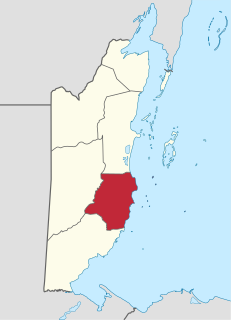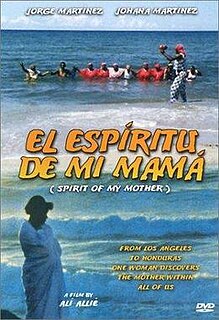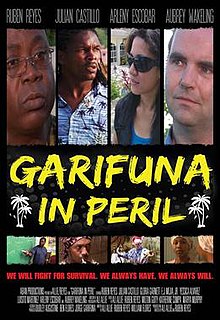
The Island Carib, also known as the Kalinago or simply Caribs, are an indigenous people of the Greater and Lesser Antilles in the Caribbean. They have descended from the Mainland Caribs (Kalina) of South America as well as the Arawakan people of the Greater Antilles. The women and children spoke an Arawakan language known as Eyeri. Meanwhile the men spoke a carib pidgin language of Karina origins.

Dangriga, formerly known as Stann Creek Town, is a town in southern Belize, located on the Caribbean coast at the mouth of the North Stann Creek River. It is the capital of Belize's Stann Creek District. Dangriga is served by the Dangriga Airport. Commonly known as the "culture capital of Belize" due to its influence on punta music and other forms of Garifuna culture, Dangriga is the largest settlement in southern Belize.

Stann Creek District is a district in the south east region of Belize. According to the 2010 census, the district had a population of 32,166 people. Its capital is the city of Dangriga, formerly known as "Stann Creek Town." Stann comes from "stanns," or safe havens used by colonialists coming from the "old world" to the "new world."
The music of Belize has a mix of Creole, Mestizo, Garìfuna, and Mayan influences. After many centuries of Maya habitation, British colonizers arrived in the area in the 17th century. Belize was Britain's only colony in Spanish-dominated Central America until self-government in 1964 and gaining full Independence in 1981. Belize is still part of the Commonwealth of Nations. Far more influential than this presence, however, was the importation of African slaves.

Black Caribs are an ethnic group native to the island of St. Vincent. Black Carib were historically referred to as zambos, since they are descendants of Island Caribs and enslaved Africans who mixed among themselves in the 18th century. This population retains Caribbean culture and makes up a very small population in the archipelago, representing the 2.0% of the current population of St. Vincent and Grenadines. There are also black Caribs in Dominica and Trinidad. The history of the Black Caribs is known due to reports that the British governor William Young sent to the British crown, in which he explained that the Black Caribs were a mix of Caribs and enslaved Africans from Spanish ships wrecked near its shores. These reports were read and taken as reference by many chroniclers and later historians. However, researchers of history and Garifuna language of the 20th and 21st centuries, such as Itarala, have their own conception of the origin of the Black Caribs. According to them, the African ancestors of the Black Caribs come from other Caribbean islands and migrated to Saint Vincent as refugees to escape slavery and as slaves bought by the Carib Amerindians. The Black Caribs are the people who originated the Garifuna people, when part of their community was expelled from St. Vincent in 1797 and exported to the island of Roatán, Honduras, from where they migrated to the coast of the mainland of Central America, spread as far as Belize and Nicaragua.
Chumba is a traditional form of music and dance performed by the Garifuna people in several Central American countries. Like punta, chumba songs are highly polyrhythmic, but have a slower tempo.

Zambo and cafuzo are racial terms used in the Casta caste class system of the Spanish and Portuguese empires and occasionally today to identify individuals in the Americas who are of mixed African and Amerindian ancestry. Historically, the racial cross between enslaved African and Amerindians was referred to as a zambayga, then zambo, then sambo. In the United States, the word sambo is thought to refer to the racial cross between an enslaved African and a white person.
Afro-Latin American or Black Latin American refers to Latin Americans of significant African ancestry. The term may also refer to historical or cultural elements in Latin America thought to have emanated from this community.

Punta is a dance originated in the Central American coast of Belize, El Salvador Honduras and Guatemala in the late 18th century with African beats.

Utila(Isla de Utila) is the smallest of the Honduras' major Bay Islands, after Roatán and Guanaja, in a region that marks the south end of the Mesoamerican Barrier Reef System, the second-largest in the world.
Garifuna (Karif) is a minority language widely spoken in villages of Garifuna people in the western part of the northern coast of Central America.
The Dugu is an ancient extended funerary ceremony practiced by the Garifuna people. The Garifuna is a small-to-medium-sized Central American ethnic group that has inhabited many Central American countries such as Belize and Honduras since the 17th century. Their roots come from both the Caribbean and African coasts. The story goes that slaves being brought over to the Americas crashed into St. Vincent. The indigenous Caribbean Indians and Africans soon formed a community and ethnic group called the Garifuna. They were identified as the "Black Caribs" to differentiate them from the native Caribbean population.

Aurelio Martínez, professionally known as Aurelio, is a Honduran musician and politician. He is a singer, percussionist, and guitarist known for his Garifuna music and is considered a Cultural Ambassador of the Garifuna people. According to the Guardian, he became the leading Garifuna performer after the death of musician Andy Palacio.

El Espíritu de mi Mamá is a Spanish language feature film by Ali Allie about Garifuna woman's journey home to Honduras to embrace her cultural roots. It premiered at SXSW in 1999 and later at Dawn Breakers International Film Festival. It was released on DVD in 2002 by Vanguard Cinema and was the first fictional movie featuring Garifuna actors in leading roles. It features an extended religious ritual segment with traditional Garifuna songs and traditional punta dance.
Afro-Hondurans or Black Hondurans, are Hondurans of African descent. They descended from Africans, who were enslaved and identified as Garifunas and Creole peoples. The Creole people were originally from Jamaica and other Caribbean islands and arrived in Honduras between the nineteenth and early twentieth century to work on the export of bananas and in construction.
Garifuna Americans are Americans of the Garifuna culture/ethnicity. As of 2012 "Abrazo Garifuna in New York", an event celebrating the contributions of Garifuna Americans to New York City is in its second year. "Abrazo Garifuna in New York" continues to be held annually as of 2014.

Garifuna in Peril is a low-budget independent fiction docufiction feature film directed, written, and produced by Alí Allié and Rubén Reyes. The film depicts historical and contemporary issues within the Garinagu Afro-Honduran indigenous community and features a cast of actors from Honduras and Belize.

The Drums of Our Fathers Monument, located at the entrance of Dangriga, Stann Creek, Belize, is a monument designed by the Nigerian sculptor Stephen Okeke, honoring the Garifuna history, culture and its beliefs.
Miriam Miranda is a Honduran activist who advocates for the human and environmental rights of the Garífuna people. As the leader of the Black Fraternal Organization of Honduras (OFRANEH), Miranda has coordinated efforts to counter land theft by big tourism businesses, reclaim ancestral territories formerly belonging to Garífuna communities, stop drug traffickers, promote sustainable environmental practices, and support community leadership development for local youth and women. She has been illegally arrested and beaten by local authorities and kidnapped by drug traffickers.











